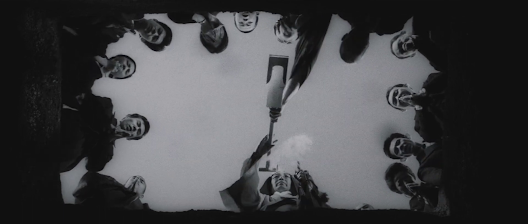Obscure Japanese Film #36
 |
| Ayako Wakao |
In the second of her three films for Yuzo Kawashima (the others being Women are Born Twice and Elegant Beast), Ayako Wakao stars as Satoko, the mistress of Nangaku Kishimoto, a famous painter (Ganjiro Nakamura) who falls ill. When his friend Jikai, a Buddhist priest (Masao Mishima), comes to visit him on his deathbed, Kishimoto asks him to look after Satoko once he’s gone. The funeral soon follows, but Satoko is unable to attend for fear of scandal, so instead she visits Jikai’s temple a week later to burn incense in tribute. Jikai tells her of Nangaku’s last wish and forces himself on her. Satoko resists at first, but soon gives in and, for lack of a better option, goes to live with him at the temple. She endures Jikai’s embraces without complaint but soon begins to feel sympathy for Jinen (Kuniichi Takami), a young acolyte who works at the temple, where he lives in a tiny, cramped room resembling an animal’s cage and is treated like a slave by Jikai.
 |
| Masao Mishima gets some good news from Ganjiro Nakamura |
Set in Kyoto during the 1930s, the story is reminiscent of Yukio Mishima’s novel The Temple of the Golden Pavilion, Kon Ichikawa’s 1958 film version of which also featured Ganjiro Nakamura – although in that film it was he who played a randy and none-too-pious priest. Like the stuttering acolyte portrayed by Raizo Ichikawa in that film, Jinen secretly despises his master, whom he sees as cynical and corrupt. Kawashima’s film is an extremely faithful adaptation of a prize-winning 1961 novella by Tsutomu Mizukami, an author better known for his Seicho Matsumoto-like social crime thrillers such as Straits of Hunger (Kiga kaikyo), brilliantly filmed in 1965 by Tomu Uchida. The Temple of Wild Geese contains strong autobiographical elements as Mizukami himself had been harshly treated as an acolyte in his youth. However, the similarities to Mishima’s work are far from coincidental as Mizukami went on to write Gobancho Yugirirou, a 1962 novel inspired by the same incident (filmed by Tomotaka Tasaka the following year) and, in 1979, a non-fiction account of the case entitled Kinkaku enjo (The Burning of the Golden Pavilion).
 |
| Kuniichi Takami |
In an effort to avoid spoilers, I’ll just say that things get quite dark in this film until a jarring transition to colour at the end when Dixieland jazz bursts out on the soundtrack and we find ourselves in the present day as tourists visit the temple to see the famous paintings of wild geese by Nangaku which decorate the interior. The credits sequence at the beginning is also shot in colour and makes good use of the same paintings, but the rest of the movie is superbly shot in black and white by Sword of Doom cinematographer Hiroshi Murai, who comes up with some quite striking compositions. Sei Ikeno’s suitably ominous music score is also a plus.
Stout character actor Masao Mishima had perhaps his largest and best screen role here as the saké-guzzling, acolyte-abusing dirty old priest, and certainly makes the most of it. His incessant humming was an especially good touch, I felt, and in his hands Jikai comes across as even more despicable than he does in the book. It’s perhaps unsurprising, then, that the film’s release was the subject of indignant protests by many among the Buddhist community in Japan at the time. The star of the show, however, is Ayako Wakao, whose performance is flawless as usual. The role is an almost perfect fit for her, while the little-known Kuniichi Takami is also a good choice as Jinen, although he understandably lacks the slightly misshapen head of the book’s protagonist.
 |
| Wakao and Takami |
So, why, despite excellent work in every department, is the film somehow less compelling than it should have been? I think there are a number of reasons. Firstly, the story lacks an obvious central character with whom we can identify. Although Satoko is sympathetic, she’s so pragmatically accepting of her fate that it’s hard to relate to her, while Jinen, with his talk of the black kite that hides half-dead snakes, fish and rats in a hole at the top of a tree, in which they squirm around in a kind of hellish menagerie,* is too creepy to win us over. I was surprised that Kawashima included this in the film but it’s quite well done. Although the pause button reveals the use of a puppet for the shot where the bird drops a snake into the hole, it’s not obvious when watching at normal speed. But it’s also an indication that this may be a rare case of a film being too faithful to its source for its own good. Kawashima shows little feel for pace, with some shots going on too long, while the music is used too sparingly and the final 15 minutes seem largely superfluous, especially the eccentric epilogue. Wakao’s big scene just before the prologue is a rare deviation from the novel, but one which seems completely over the top and was obviously motivated solely by the desire to give the star a moment of high drama to go out on. Still, despite these quibbles, I consider The Temple of Wild Geese to be an unusual film of overall high quality which is well worth seeing.
 |
| The puppet shot |
The original novella is available in a fine English translation by Dennis Washburn published by the Dalkey Archive in 2008 in an omnibus edition with the same author’s Bamboo Dolls of Echizen (also turned into a film starring Ayako Wakao).
* Author Mizukami later wrote an entire book based on this - see my review here.

No comments:
Post a Comment